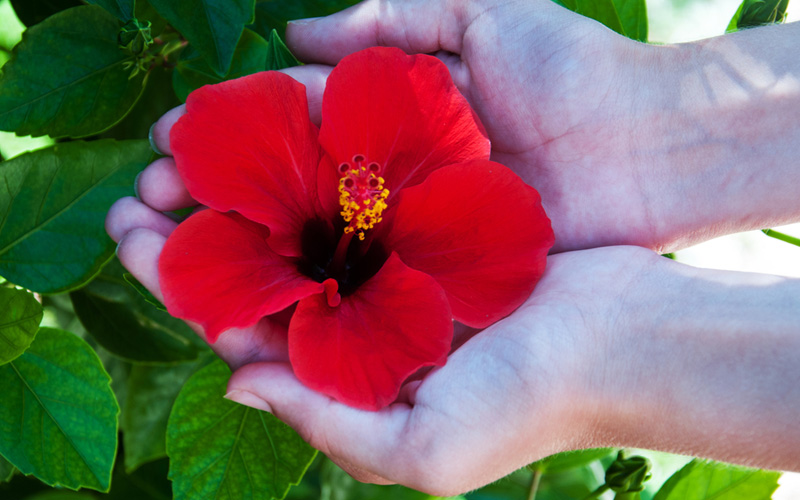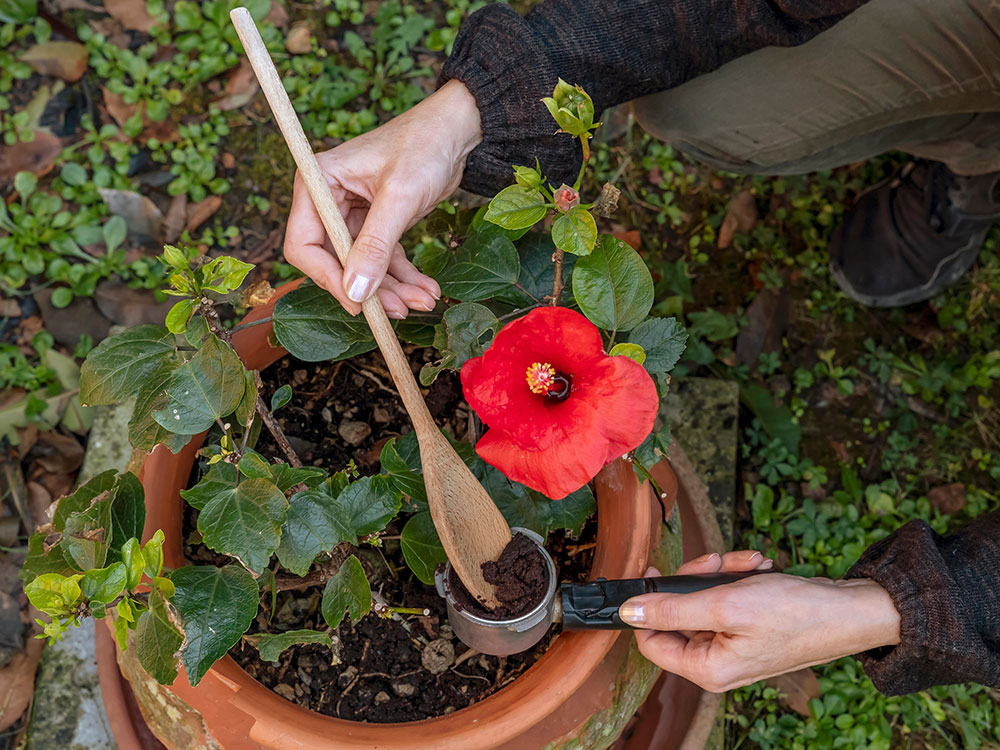
Hibiscus plants are tropical beauties that will bring an exotic look to your garden. They are durable plants that can grow to be up to 15 feet in height, and the colorful blooms will attract hummingbirds and butterflies to your garden. Since hibiscus plants are tropical, they need a certain amount of care to ensure that they thrive in other environments.
My garden is filled with these breathtaking beauties, and I know that with the right care, a hibiscus plant will reward you greatly. They look amazing when they are planted together, but if you have a small gardening space, then you can grow a hibiscus plant and make it the focal point in your garden instead. Since these plants can be difficult to care for, let me give you a few tips to get started with.
How to Plant and Care for Hibiscus
Hibiscus does not take a lot of effort to care for; it simply needs to have certain conditions in order to thrive. Let’s take a look at a few suggestions for growing a healthy, happy hibiscus plant.
Type of Soil
Hibiscus likes to be planted in soil that is slightly acidic. If the soil in your garden is not acidic, you can attempt to increase the level by adding peat moss to your garden. When you plant the hibiscus, place them in the soil about two or three feet from each other; these plants may seem small now, but they will grow to be pretty large with time. In addition, do not plant these plants before the frost threat is over for the year to ensure that they survive the cold temperatures.
Watering Hibiscus
Hibiscus need moist soil to grow, but it also needs to be drained well. This is so that the roots are not sitting in a large amount of water, which can cause the roots to rot. If the plant is under-watered, then it is possible that the blooming process would stop, since this is a method to protect the roots of the plant. The best way to ensure that the plant will be getting adequate water is to use an irrigation system that will drain out any excess water.

Optimal Lighting
The best location for a hibiscus plant is a location that is going to get direct sunlight for five to six hours a day. They will grow in partial sunlight, but at the expense of the blooms being produced. For optimal growth, the plant needs to have full sun as much as possible.
Temperature Requirements
A hibiscus plant will flourish the most in temperatures that remain between 60 degrees Fahrenheit and 90 degrees Fahrenheit. Once the temperatures start coming close to the 32 degree Fahrenheit mark, the plants must remain indoors so that the cold weather does not cause damage to the plant.
Pruning Hibiscus
Hibiscus plants do not need to be pruned, but with that being said, the plant will love the additional attention. If you are going to prune a hibiscus plant to rejuvenate its look, it should be done in early spring. This will stimulate the budding process and help the plant thrive throughout the summer months. If you happen to prune your hibiscus plants late in the season, do not trim the branches too far back because it can hinder the blooming process.

Fertilizing Hibiscus
When you fertilize your hibiscus plant, it is a good idea to utilize liquid fertilizer to ensure that it can be dispersed through the soil evenly. You will want a fertilizer that is high in potassium because it’s great for the growth of hibiscus plants, but you also want to avoid phosphorus because it is a mineral that can kill the hibiscus plant, especially if the mineral is accumulating in the soil. A great way to encourage growth in the plant is to add compost bark or worm castings to the soil once a year or more.
Wintering Hibiscus
If the temperature where you live tends to drop below 32 degrees Fahrenheit over the winter, then you will need to take precautions to ensure that the hibiscus plant is safe. First, you need to bring the plant indoors to a location that stays above 50 degrees Fahrenheit. It will also need a steady supply of sunlight and fresh water, though the plant will require less during the winter.
Over the winter, you may notice that your plant’s leaves are turning yellow. This is a trait that will develop if you have been overwatering your hibiscus plants. They should be watered regularly throughout the season, but only when the soil is dry to the touch. Any more than that can mean that you are overwatering the plant, and the leaves will begin to turn. If the leaves begin to fall from the plant, it is likely that the hibiscus is entering into a dormant state which means that the hibiscus will require a cool damp location to remain in that state during the winter.
Growing Hibiscus in Containers
Many find that growing hibiscus in a container is easier than growing the plant directly in the garden. If you plant the hibiscus in a pot, you can move it easily to make sure that it gets the light that it requires to grow. In the winter, you can make sure that the temperature is warm enough for the plant to survive, and if it suddenly is below freezing outside, you can quickly move the hibiscus indoors. Make sure that the planter is a pot that drains well. In addition, stone pots tend to encourage hibiscus growth, which is preferred for hibiscus plants rather than using a clay pot that can make the soil alkaline over time.

Propagation
Propagating a hibiscus plant begins with a hibiscus soft wood cutting. This is a branch of an existing plant that has not yet matured. The limb will still be a bit soft, so be careful when trimming it. The cuttings should be four to six inches in length, and it should still have leaves on the end of it. Place the cutting into some well draining soil to encourage it to take root. Cover the cutting to create a greenhouse effect for the young plant and keep the soil moist until the plant takes root. Using this method, a duplicate plant will form.
Propagating with a seed is also a possibility, though the conditions need to be just right for it to work in most situations. Use the tip of a pen to create a small hole to place the seeds in, then you can cover the holes and water the soil where the seeds have been planted. Seedlings should peek through the soil in about two to four weeks.
Common Problems That Hibiscus Plants Have
Hibiscus plants can have an issue with the leaves turning yellow. This is often caused by too much water being given to the plant during the winter months. If this occurs, simply reduce the amount of water that you give to the plant, especially if it is dormant. On extremely hot days, there is also a chance that the leaves of the plant could burn. Even though hibiscus is a tropical plant, you may need to move it to a shady location once in a while. Aphids, mites, and whiteflies can also cause issues for hibiscus plants, so if you notice an infestation, use mild dish soap to clean the leaves. Some gardeners have reported buds falling before blooming – in this article you can find some tips to prevent Hibiscus flowers from falling.
Hibiscus plants are beautiful flowering bushes that take a lot of care, but if you are looking for a tropical touch to add to your garden, you have found the perfect plant. The short bloom life of a hibiscus is nothing to concern yourself with; you will see fresh new blooms by morning. Simply enjoy the colorful blooms before they begin to wilt during the afternoon.
If you want to learn more about the Hibiscus, check out these guides here:













